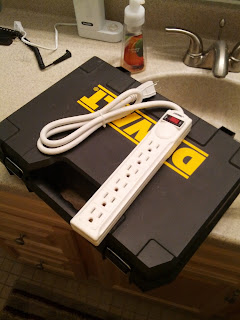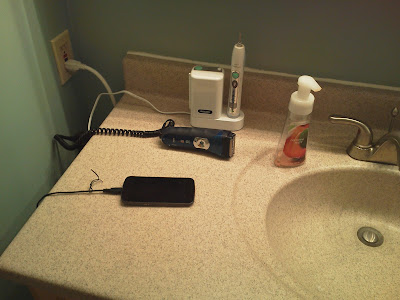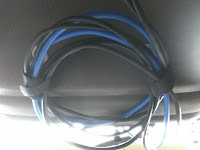Is it weird to want more power sockets in the bathroom? I think not.
It's the twenty-first century. Between my wife's gadgets and my own, we usually have three or four devices fighting for the two sockets in the bathroom. Well, that changes tonight.
Preparation
I happened to be in K-Mart today, and I picked up a simple six-socket power strip. Nothing fancy. Notably, it does have surge protection, which I figured was wise given that it'll be in the bathroom (I'm not really concerned about getting zapped if an accident occurs, though, because the wall socket itself has surge protection circuitry).
But key to this endeavor: The strip has two screw collars on the back. Bingo.
Honestly, the hard part was finding the screws to fit those collars. I have several screws of various sizes, but those collars have extremely tight tolerance. I needed a shallow head and pretty narrow shaft. I had to paw around for awhile in my screw box, but I finally found two that fit the bill.
Ten-minute Hack
This is an easy one. I slid the screws into the collars, positioned the power strip where I wanted it, and wiggled it around a bit to etch the screw tips into the wood. Now, I just have to whip out my trusty DeWALT and...
... oops. Hard to tell in the photo, but that's only eight inches of clearance.
Okay! Quick change of tools: Papa Tomczak ages ago gifted me with a spare screwdriver, intended for computer repair. Turns out, it's just the right length and torque to fit this project, if I add a liberal amount of elbow grease.
In point of fact, I needed a lot of elbow grease. The side of the sink cabinet is some kind of pressed particle board, and it took some "oomph" to cut through the outer layer. Once I could get the screws to bite, though, they went in easy.
Then it was just a bit more elbow grease to get the collars to set back on the screws and...
Now all of the bathroom's little electronic residents have a home.
Final Thoughts
I might use some more velcro ties to pretty-up the loose wire between the power strip and the wall socket, but I'm overall pleased with the outcome.












